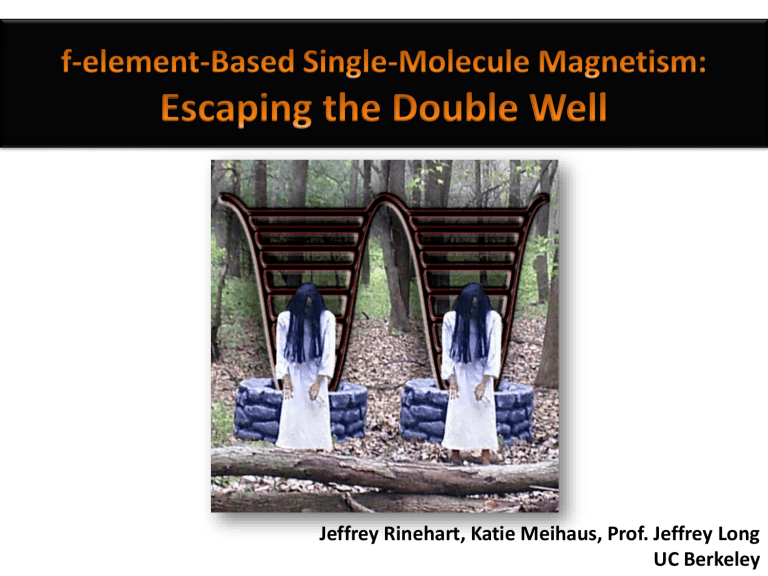f-Element-based single molecule magnetism - Escaping the

Jeffrey Rinehart, Katie Meihaus, Prof. Jeffrey Long
UC Berkeley
f-elements in Single-Molecule Magnetism
La Ce Pr Nd Pm Sm Eu Gd Tb Dy Ho Er Tm Yb Lu
Ac Th Pa U Np Pu Am Cm Bk Cf Es Fm Md No Lr
Vast majority of SMM papers published in the last ten years were based on iron and manganese oxo clusters
Growth in An/Ln papers published is significant
Exploiting Magnetocrystalline (Single-ion)
Anisotropy low energy high energy
1) Strong spin-orbit coupling
2) Large unquenched orbital moment
3) Anisotropic f-electron density
3
A Tricapped Trigonal Prismatic U(III) Complex
UI
3
+
THF
(H
2
BPz
2
) 1-
B-H stretching frequencies are consistent with a U-H interaction at the lateral faces of the trigonal prism
U(H
2
BPz
2
)
3
Structure: Sun, Y.; Takats, J.; Eberspacher, T.; Day, V. Inorg. Chim. Acta 1995, 229, 315.
Magnetism: Rinehart, J.; Meihaus, K.; Long, J. J. Am. Chem. Soc. 2010, 132, 7572.
with Katie Meihaus
Multiple Pathways to Magnetic Relaxation
Fast Relaxation Domain
Slow Relaxation Domain
Multiple relaxation processes are difficult to explain with only a single paramagnetic ion per cluster
Field Dependence of Magnetic Relaxation Times
U(H
2
BPz
2
)
3
(Fast Domain)
1.8 K
(Slow Domain)
U(Ph
2
BPz
2
)
3
(Fast Domain)
Magnetic Dilution of U(H
2
BPz
2
)
3
3
YCl
3
:UI
3
+
THF
(H
2
BPz
2
) 14% U(H
2
BPz
2
)
3 in Y(H
2
BPz
2
)
3
Similar ionic radii allow co-crystallization of U(H
2
BPz
2
)
3 in Y(H alteration of the space group or crystal field environment
2
BPz
2
)
3 without
In undilute structure, four uranium ions are ~8.6 Å from each uranium ion
Katie Meihaus
Results of Magnetic Dilution of U(H
2
BPz
2
)
3
U eff
/k
B
= 23 K
U eff
/k
B
= 11 K
Fast Domain relaxation is slowed considerably and anisotropy barrier doubles.
Slow Domain relaxation is eliminated
How much is the magnetic relaxation modulated by the concentration of magnetic ions?
Katie Meihaus
A Test Case for the Affect of Magnetic Dilution:
Neodymium(III) tris(trispyrazolylborate)
C
NdCl
3
+
H
2
O
N
Nd
B
NdTp
3
Tp
(trispyrazolylborate anion)
Tricapped trigonal prismatic coordination leads to D
3h site symmetry.
High symmetry should hinder direct tunneling relaxation pathway (Kramers ion)
Structure: Apostolidis, C et. al. Polyhedron . 1997 , 16 , 1057.
f 3
The Electronic Structure of NdTp
3
2 H 4 F
7/2
4 F
4 I
(2S+1) L
Electrostatic
Repulsion
4 H
9/2
4 F
5/2
4 F
3/2
4 I
15/2
4 I
13/2
4 I
11/2
4 I
9/2
107 cm -1
(2S+1) L
J
Spin-orbit
Coupling m
J
Ligand Field
Splitting
Reddmann, H. et. al. Z. Anorg. Allg. Chem. 2006, 632, 1405.
Slow Magnetic Relaxation in NdTp
3
C
N
Nd
B
Requires application of > 100 Oe dc field to observe out-of-phase signal
Relaxation data can be fit to give U eff
~3 cm -1 (4 K) and τ
0
= 4x10 -5 s
=
3 % of expected barrier!
Effect of LaTp
3
Dilution on NdTp
3
Relaxation
1:30 dilution results in 650% increase in relaxation time at 1.8 K
Relaxation time vs. % NdTp
3
Data are fit empirically to the equation τ = 0.0105*(Percent NdTp
3
) -0.684
Relaxation time is slowing but are we approaching predicted Arrhenius behavior?
Effect of Dilution on Arrhenius Behavior in NdTp
3
U eff
/k
B
= 6 K; τ
0
= 2x10 -4 s -1
U eff
/k
B
= 5 K; τ
0
= 1x10 -4 s -1
U eff
/k
B
= 5 K; τ
0
= 6x10 -5 s -1
U eff
/k
B
= 4 K; τ
0
= 4x10 -5 s -1
Dilution drastically alters relaxation time but has little effect on anisotropy barrier
Effect of Dilution: Drastic But Not that Drastic
4
2
0
-2
-4
-6
-8
-10
-12
0 0,2 0,4 0,6
1:1 Dilution
No Dilution
1:10 Dliution
1:30 Dilution
Orbach low freq limit high freq limit
1/T (K -1 )
Long range effects cannot fully account for the discrepancy between observed behavior and that predicted by the electronic structure of NdTp
3
Predicted vs. Actual Magnetic Behavior
(guess which is better)
Compound Predicted Barrier (K) Measured Barrier (K) Percent of Expected Barrier
UTp
3
NdTp
3
[TbPc2] -
388
154
619
6
4
331
1.5%
2.6%
53.5%
U(COT)
2
[Er(W
5
O
18
)
2
] 9-
662
144
0
55
0.0%
38.2% f-element mononuclear single-molecule magnets have shown impressive new behavior, yet the factors governing their relaxation must be better understood to fully exploit their potential
Radial Extension of the f-orbitals
La Ce Pr Nd Pm Sm Eu Gd Tb Dy Ho Er Tm Yb Lu
Ac Th Pa U Np Pu Am Cm Bk Cf Es Fm Md No Lr
Nd 3+ U 3+
Adapted from Crosswhite, Crosswhite, Carnall, Paszak J. Chem. Phys. 1980 , 72 , 5103
N
2
3– Radical-Bridged Lanthanide Complexes
Ln
2
N
2
Si
Ln
N
O
C
[Ln
2
N
2
] n (Ln = Gd, Dy; n = 0,
1)
[Ln
2
N
2
]
[Gd
2
N
2
]
: Possibility of strong exchange coupling
[Dy
2
N
2
]
: High anisotropy could make it a SMM
With Dr. Ming Fang, Prof. William Evans at UC Irvine
Strong Antiferromagnetic Coupling in [Gd
2
N
2
]
S =
1/2
S =
7/2
Ĥ = -2J [Ŝ rad
• (Ŝ
Gd1
+ Ŝ
Gd2
)]
J =
27 cm -1
J =
0.49 cm -1
Ĥ = -2J [Ŝ
Gd1
• Ŝ
Gd2
]
2 2 2 2
]
Gadolinium complexes tend to have coupling constants of
2 < J < 2 cm -1
Magnetic Susceptibility of Dy
2
N
2
and [Dy
2
N
2
]
[Dy
2
N
2
]
Dy
2
N
2
Steep rise in
T is highly unusual and indicative of strong magnetic coupling, however quantitative analysis is hindered by Dy(III) electronic structure
Single-Molecule Magnetism in [Dy
2
N
2
]
Ac susceptibility data fit using generalized Debye model between 1 –1500 Hz and 10 –19 K.
Arrhenius Behavior of [Dy
2
N
2
]
[Dy
2
N
2
]
U eff
0
= 123 cm -1
= 8 x 10 -9 s
(178 K)
Dy
2
N
2
U eff
0
= 18 cm -1 (26 K)
= 2 x 10 -6 s
Linear ln(
) vs. 1/ T indicates an Arrhenius temperature dependence of the relaxation process
Magnetic Hysteresis in [Dy
2
N
2
]
Although Arrhenius behavior persists to low temperatures, eventually anomalously fast zero field relaxation is observed
[TbPc
2
]
Context of [Dy
2
N
2
]
Among
Single-Molecule Magnets
[Dy
2
N
2
]
Arrhenius prediction for 1 s relaxation
Mn
12
-OAc
Newest dysprosium-based single-molecule magnets have barriers and hysteresis temperatures more than double that of Mn
12
-OAc
Is increasing the anisotropy barrier the most interesting synthetic goal?
Remaining Questions
What is the source and can we model the behavior of the Slow Domain relaxation process?
U(H
2
BPz
2
)
3
What is the extent of dilution effects on relaxation?
NdTp
3
Is there a way to model the magnetic coupling of
[Ln
2
N
2
]
? Will other lanthanides yield higher relaxation barriers?
[Ln
2
N
2
]
Acknowledgments
Jeffrey R. Long
Katie Meihaus
William Evans
Ming Fang
Stephen Hill
Enrique del Barco
Coordination Sphere of U(H
2
BPz
2
)
3 and U(Ph
2
BPz
2
)
3
3.0 Å
73.6
80.2
3.2 Å
U(Ph
2
BPz
2
)
3 U(H
2
BPz
2
)
3
Ligand Field Perturbations:
1) Coordination increased from trigonal prismatic to tri-capped trigonal prismatic
2) N-U-N angle increases
3) Distance between triangular faces of prism increases
3
UI
3
+
A Trigonal Prismatic U(III) Complex
Showing Single-Molecule Magnetism
THF
(Ph
2
BPz
2
) 1U(Ph
2
BPz
2
)
3
mononuclear U(III) molecular species with pseudo-3–fold symmetry axis
axially coordinated ligand density forms trigonal prismatic crystal field
Maria, Campello, Domingos, Santos, Andersen. J. Chem. Soc., Dalton Trans. 1999, 2015
Single-Molecule Magnetism in U[Ph
2
BPz
2
)
3
frequency dependency of out-of-phase susceptibility (χ
) is the signature of lowdimensional slow magnetic relaxation
effective barrier height invariant to applied dc field, measurement technique, and sample preparation
Rinehart, Long J. Am. Chem. Soc. 2009, 131, 12558
DC Field Dependence of the Relaxation Time
U eff
τ
0
= 20 cm
= 1x10 −9 s
−1 relaxation times (
) obtained by fitting both
and
between 1-1000 Hz to a generalized Debye equation high temperature linear region defines the thermally-activated regime
Quantum Effects on Relaxation Times in U(Ph
2
BPz
2
)
3
1.8 K
small applied dc fields may break QTM pathways and force the slower process of thermal relaxation






